- Home
- Comparing Alternatives
- Top 5 Mailchimp Alternatives: ...

Mailchimp is rightfully considered a veteran in the world of email marketing, known for its advanced functionality. However, the rise of new platforms is reshaping the landscape of email marketing, offering functionalities that often surpass those of the good old Mailchimp.
This article explores how Mailchimp stacks up against emerging alternative platforms. By comparing Mailchimp to its five potential competitors — Constant Contact, Campaign Monitor, Brevo, Moosend and Omnisend — we aim to give you a comprehensive overview of the most notable marketing platforms. Armed with this knowledge, you’ll be able to make more informed decisions on the best tools to enhance your email marketing strategies.
1. Constant Contact
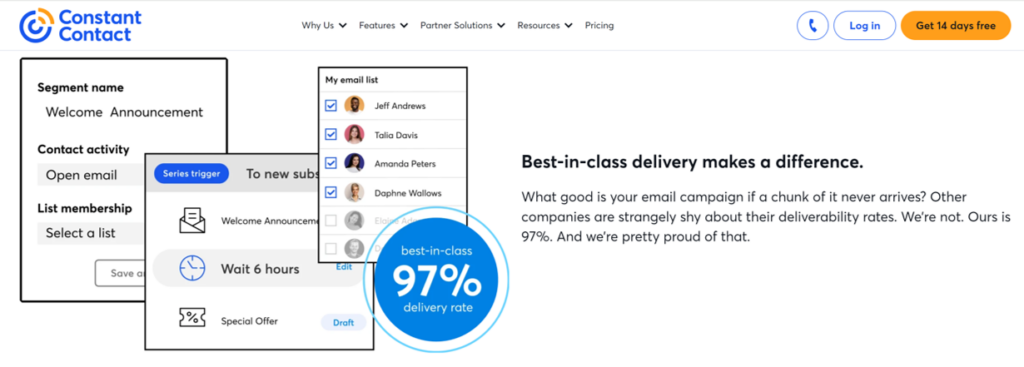
Constant Contact is one of the oldest players in the email marketing field, founded in 1995 in the USA. It has evolved significantly over the years, expanding its service offerings beyond email marketing. Known for its reliability and extensive customer support, Constant Contact has grown to serve a wide range of businesses globally, maintaining its status as a leader in the industry.
Constant Contact features
Constant Contact has evolved to include unique features that set it apart from Mailchimp and other competitors. It offers event management tools and social media campaign capabilities that are particularly valuable for businesses that engage in event-oriented marketing and social media interactions. These features provide an integrated approach to managing and promoting events directly through the email marketing platform, which can be a significant advantage for users in niche markets.
The automation features of Constant Contact are less advanced and diverse than those of Mailchimp. Nonetheless, its list management is similar to Mailchimp, with lists, segments, and tags. The latter might be an advantage for some but cause confusion for others.
Both platforms have a wide choice of templates. While Mailchimp is often criticized for having rigid and too few templates available on a free plan, Constant Contact does not have templates on a free plan at all. Why? About that, read further.
Constant Contact pricing plans
Unlike most other email marketing platforms, Constant Contact does not offer a free plan at all.
Its Lite plan starts at $12/month for up to 500 subscribers and altogether has quite limited functionality, but costs can increase significantly with the number of subscribers. This pricing structure may be a concern for businesses that expect to grow quickly or are simply looking for free Mailchimp alternatives.
Unlike Mailchimp, which offers a “free forever” plan, Constant Contact only provides a 30-day free trial. This could be a limiting factor for small businesses or startups that are cost-sensitive and looking to minimize initial expenses.
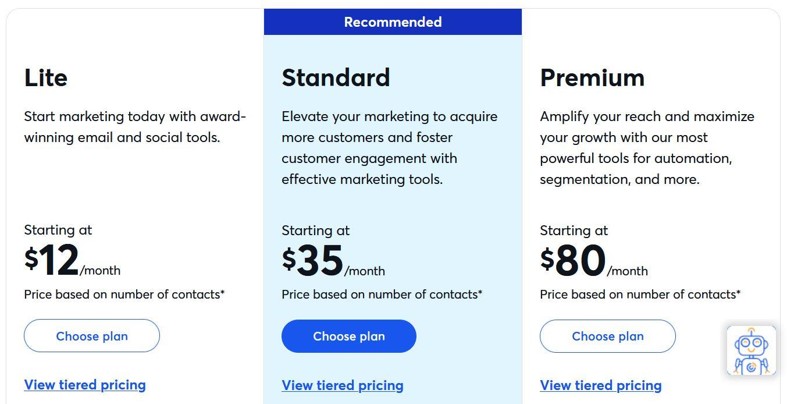
User interface and ease of use
Constant Contact is praised for its straightforward user interface, which guides users through the setup process, from account creation to campaign execution. The platform’s design focuses on simplicity and effectiveness, ensuring that even those new to email marketing can start their campaigns without a steep learning curve.
Mailchimp’s user interface is usually considered user-friendly too, even though it may be less so in comparison to some other less advanced platforms, which makes sense for a feature-rich platform.
Integration capabilities
Mailchimp has over 250 integrations, which is about the same as Constant Contact’s number of integrations. With such variety comes extensive flexibility, allowing users to connect with virtually any tool they might use, including major e-commerce platforms like Shopify and Wix, Squarespace, eBay, or Etsy.
Customer support and resources
Constant Contact is one of email platforms like Mailchimp but with far better customer support, available via live chat and phone with extensive hours. The platform provides dedicated phone numbers for various countries, enhancing accessibility for international users. While support is not available 24/7, the available times are generous and tailored to provide help during peak business hours.
This variety and accessibility make Constant Contact stand out in comparison with Mailchimp, which caters to its customer support for different types of plans.
Specific advantages for different business sizes or sectors
Constant Contact’s specialized tools make it an ideal choice for businesses that heavily engage in event marketing or that utilize social media campaigns extensively. Its targeted features offer significant benefits for sectors like real estate, where direct engagement and event management are crucial.
2. Campaign Monitor
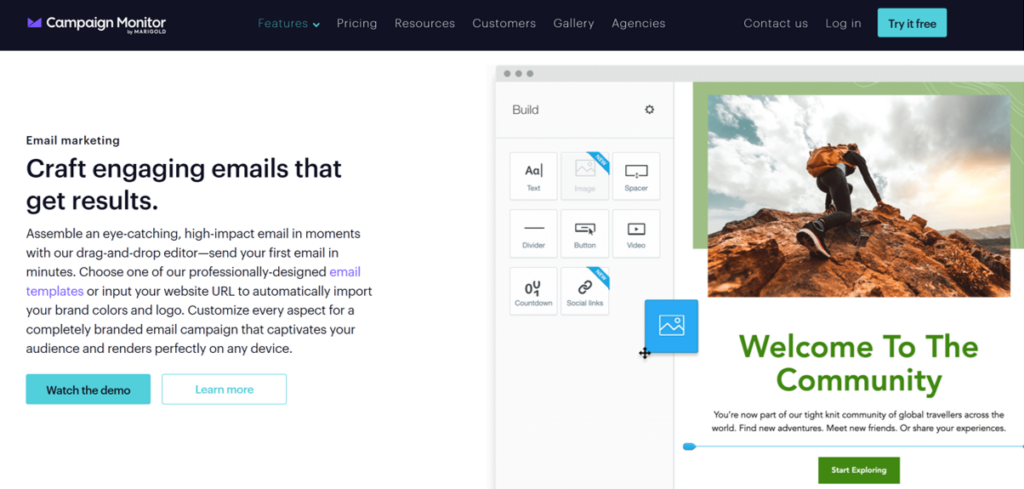
Campaign Monitor is a Mailchimp alternative that began its journey in 2004 in Sydney, Australia. It was founded to provide beautiful, simple email marketing tools tailored specifically for agencies and professional marketers. Over the years, Campaign Monitor has grown significantly and now serves a global clientele, offering tools that empower users to create unique and effective email marketing campaigns.
Campaign Monitor vs Mailchimp: Feature comparison
Campaign Monitor offers robust reporting capabilities that make it easy for users to pull the data they need for effective campaign management. While Mailchimp also provides comprehensive analytics, Campaign Monitor is particularly noted for its dynamic reporting tools, which can be advantageous for marketers focused on data-driven decisions.
Both platforms offer a range of customizable templates, but Campaign Monitor is renowned for the quality and aesthetics of its pre-made templates, many of which look bold and eye-catching. Mailchimp’s collection looks more boring in comparison.
Besides, users report having an easier time managing subscription lists when you can easily subscribe or unsubscribe users. On the contrary, Mailchimp lists are more rigid, which often comes at additional cost as well.
Campaign Monitor pricing plans
In contrast to Mailchimp, Campaign Monitor does not offer a free tier, which can be a significant consideration for those looking for free Mailchimp alternatives. Campaign Monitor’s pricing is based on the volume of emails sent and the number of subscribers, which can scale up depending on the business’s growth and needs. They also offer a “pay per campaign” option, which might suit those sending emails on a non-systematic basis.
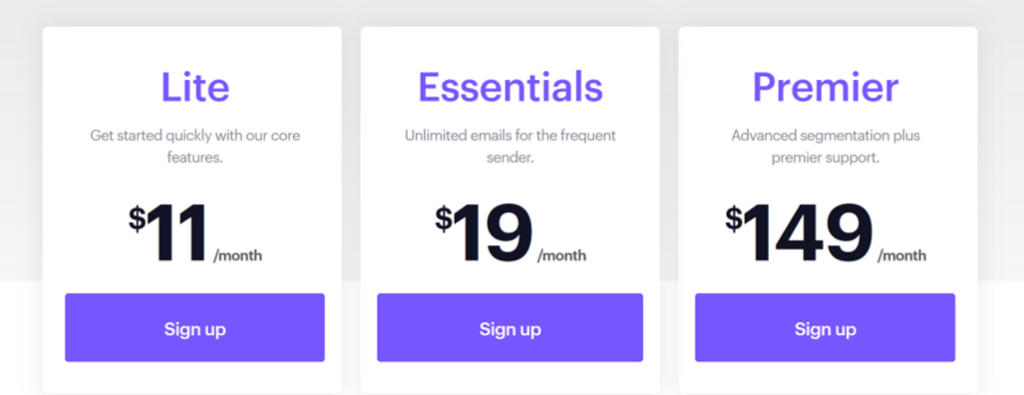
User interface and ease of use
Altogether Campaign Monitor interface feels more dynamic, vibrant, and modern than the one of Mailchimp. It also feels more intuitive and clearer when navigating, conveniently clustering all the important information into relevant sections and guiding you through it.
Mailchimp often feels like an easier-to-get-lost place when looking for a feature you need or building a campaign.
Integration capabilities
Campaign Monitor offers over 250 integrations with various tools and platforms, which are conveniently clustered into sections like advertising, signup forms, email testing, and others.
Nonetheless, it lacks direct integrations with social media platforms like Instagram and some CRM software, which could be a limitation for businesses that rely heavily on these channels.
Mailchimp, known for its extensive range of integrations, may offer broader connectivity options compared to Campaign Monitor, especially in areas directly affecting social media marketing and customer relationship management.
Customer support and resources
Altogether Campaign Monitor support is praised by users as “quick,” “strong,” and “amazing.” This contrasts with some of the feedback about Mailchimp’s support, which is mixed, with some users finding it less helpful than expected.
Specific advantages for different business sizes or sectors
With its bright email templates, the platform might provide good options for designers. At the same time, its comprehensive features, supported by advanced analytics, make it a platform of choice for businesses of all types and sizes—from the Australian Red Cross to media and publishers and hospitality industries.
3. Brevo (formerly Sendinblue)
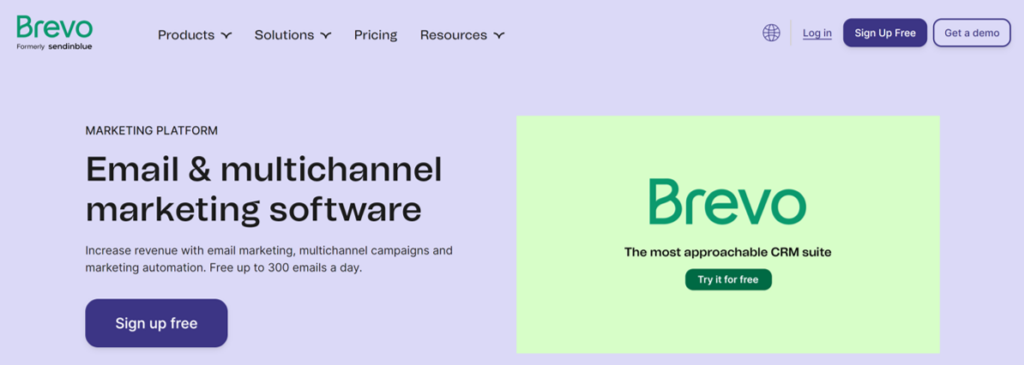
Founded in 2012 in France, Brevo has carved out a niche by focusing on providing straightforward and accessible email marketing tools, quickly becoming a favorite among small to medium-sized businesses. Its design and services are crafted to appeal to an international audience.
Brevo vs Mailchimp feature comparison
When it comes to the comparison of features like automation, it is worth mentioning that Mailchimp is recognized for sophisticated automation capabilities such as welcome emails, abandoned cart reminders, and personalized product recommendations. However, user feedback often indicates instability in Mailchimp’s automation processes, leading to user dissatisfaction. Adding to that, while automation is available as a preview on a free plan, to use it, you’ll need to upgrade.
Brevo offers robust automation tools that are more streamlined and user-friendly, making it a strong competitor for businesses looking for reliable and efficient marketing automation. Besides, and that’s a big one, Mailchimp does not provide automation on its free plan, meaning you’ll have to pay even for a regular automated welcome email. So, Brevo might be your choice if you are looking for email services like Mailchimp but with free automation.
Another point is contact segmentation; with Brevo, it is very straightforward, while with Mailchimp, users often complain about confusion between groups, segments, and tags. Plus, Mailchimp’s pricing is based on the number of subscribers, which means if the same contact appears on multiple lists, you end up paying for them more than once—quite a discouraging practice unique to Mailchimp.
Brevo also counters its competitor with its easy-to-use drag-and-drop editor and responsive design capabilities.
Brevo pricing plans
Mailchimp’s pricing model is seen as unfriendly, especially as businesses scale, which includes abrupt pricing increases and limitations under its free tier.
Brevo emerges as a cost-effective Mailchimp alternative with its straightforward pricing structure, offering a free plan and low-cost paid options that are transparent and scalable.
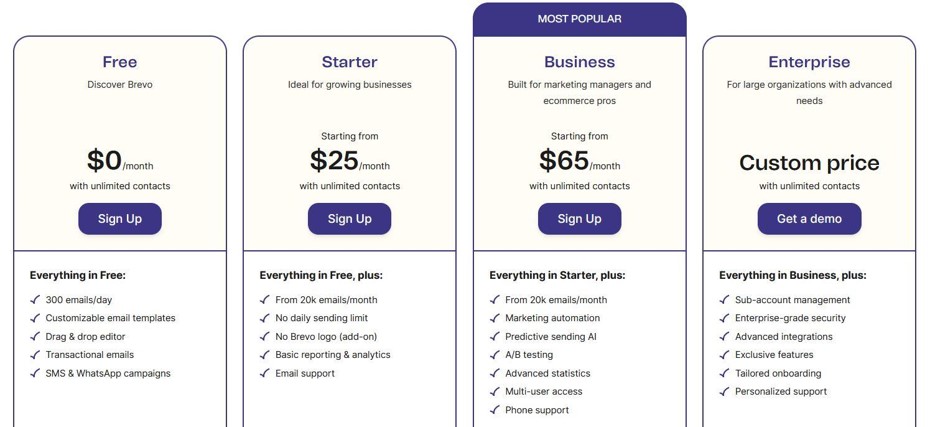
While Mailchimp has challenges with scalability due to its pricing structure, Brevo provides a scalable solution that accommodates growth without substantial price hikes, presenting a budget-friendly alternative for growing businesses.
User interface and ease of use
Brevo is praised for its intuitive interface that simplifies email marketing, making it a viable option for those who may be less tech-savvy. On the contrary, Mailchimp’s platform, while being feature-rich, can be overwhelming for beginners, as was previously noticed.
Integration capabilities
Both platforms offer robust integration options with essential e-commerce and CRM tools. However, integration challenges with Mailchimp have been often highlighted in forums.
Brevo, on the other hand, maintains a competitive edge with seamless integration capabilities that are consistently reliable.
Customer support and resources
Mailchimp’s customer support is sometimes seen as inadequate in resolving issues and providing different levels of support depending on the plan.
Brevo is noted for its overall good support across all plans, even though for some questions you are directed just to their knowledge base.
Sector-specific advantages
Brevo is considered a compelling alternative for e-commerce and blogging. Brevo’s straightforward tools and effective automation can significantly benefit small to medium-sized enterprises looking to enhance their marketing with minimal hassle.
4. Omnisend
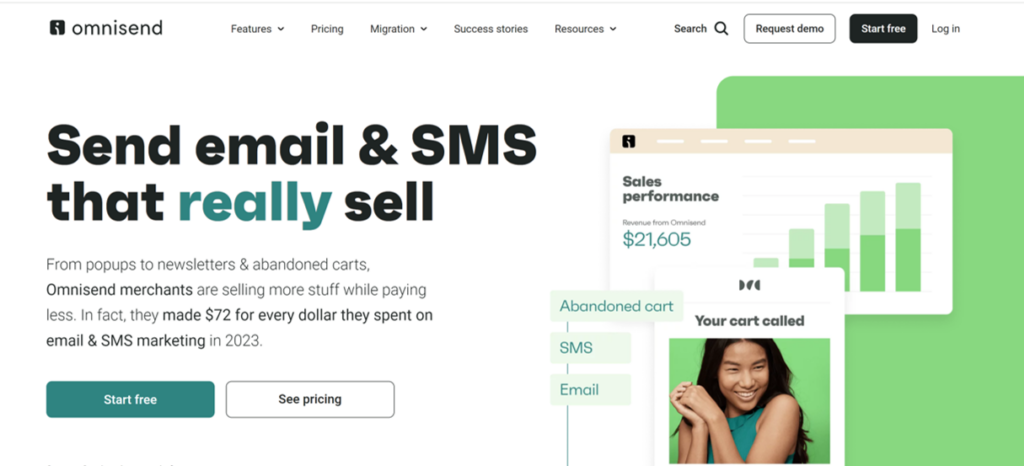
Omnisend was launched in 2014 in Lithuania and quickly distinguished itself by focusing on e-commerce businesses. Omnisend’s innovative approach to integrating email with other marketing channels has helped it secure a prominent place in the market, serving clients worldwide.
Omnisend vs Mailchimp feature comparison
Omnisend offers powerful automation capabilities tailored specifically for e-commerce, including pre-built workflows designed to increase customer engagement and sales. This focus on e-commerce distinguishes Omnisend from Mailchimp, which, while offering a broad range of features, does not specialize as intensely in e-commerce automation. Omnisend’s advanced segmentation and personalized campaign capabilities further enhance its suitability for online retailers.
Both Omnisend and Mailchimp provide template offerings, but Omnisend’s templates are particularly designed to support e-commerce activities, which can be a significant advantage for businesses in that sector. While the overall choice of Omnisend templates is less than those available on Mailchimp, they are available across all company’s plans. At the same time, free Mailchimp templates are often seen as hard to work with, which makes Omnisend a good alternative to Mailchimp in this regard.
Omnisend pricing plans
Both Omnisend and Mailchimp scale their pricing based on the number of contacts you have, but Omnisend’s plans are particularly designed to scale with the growth of an e-commerce business, offering more advanced features at higher tiers.
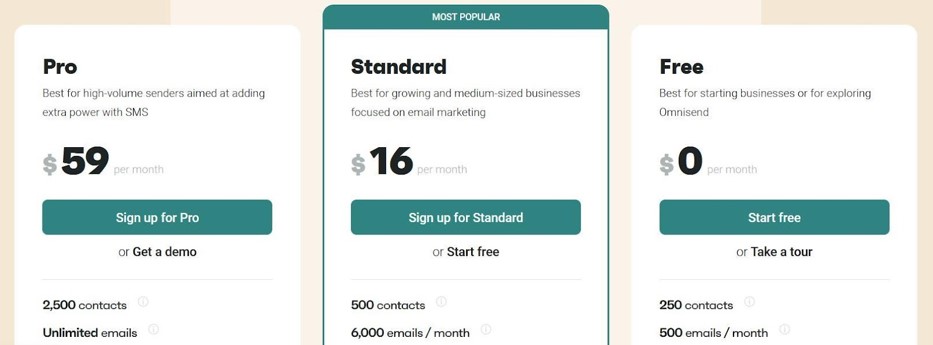
Both platforms offer free plans. While Omnisend’s free plan caters to 250 contacts/ 500 emails per month, Mailchimp offers 1000 emails per month for 500 contacts (which is a minimum number for the platform). Nonetheless, the Omnisend free plan seems to be more feature-rich when compared with Mailchimp.
While standard plans seem to be relatively comparable for both companies, the difference between premium plans is obvious.
User interface and ease of use
Omnisend is renowned for its user-friendly interface, which includes intuitive design elements and easy-to-use automation workflows. This makes it accessible to users of all technical levels. Mailchimp also boasts a simple and clean interface with a drag-and-drop email builder that has long been favored by beginners.
Integration capabilities
Omnisend offers over 130 integration options, facilitating seamless connections with a variety of e-commerce platforms and other tools. This extensive integration ecosystem is crucial for e-commerce businesses and makes Omnisend a strong Mailchimp competitor in this field.
Mailchimp provides an overall greater number of integrations, but with a broader focus beyond just e-commerce.
Customer support and resources
Omnisend offers 24/7 customer support through email and live chat on any plan, along with educational resources such as guides and webinars to help users maximize their use of the platform.
That differentiates it a lot from Mailchimp, which provides access to all support channels only for users on the Premium plan. Users on the Free plan can, unfortunately, talk only with a chatbot.
Specific advantages for different business sizes or sectors
As was already mentioned, Omnisend is particularly beneficial for e-commerce businesses due to its specialized tools and workflows designed to enhance online sales processes. Mailchimp, on the other hand, caters to a broader audience, from fintech to virtual healthcare to real estate. This alone does not make Omnisend better than Mailchimp, but rather sets it apart as a platform for a more specific niche.
5. Moosend
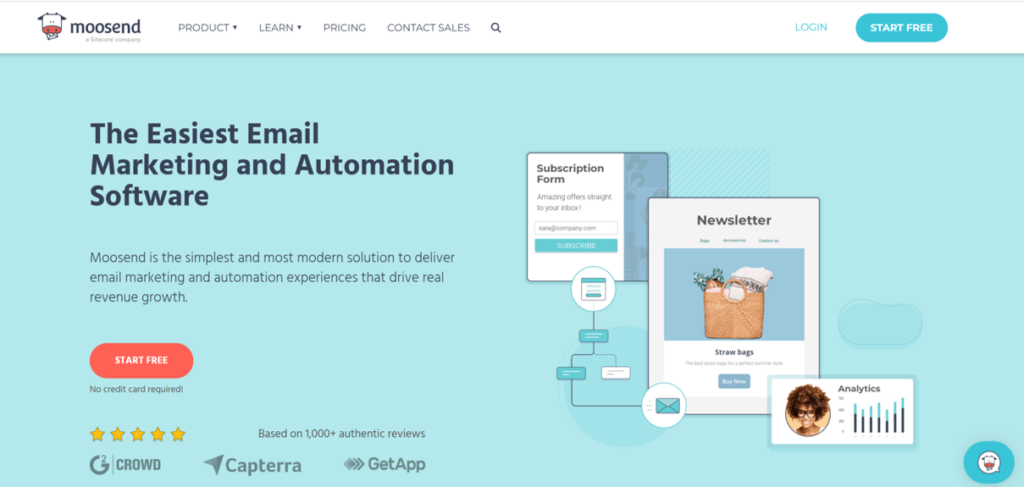
Moosend was founded in 2011 in the United Kingdom. Since its inception, it has grown significantly and is known for its affordability and robust automation features. Moosend has built a reputation for being particularly user-friendly, which has helped it expand its presence on an international scale and cater to a diverse range of businesses around the world.
Moosend features
Moosend offers essential marketing automation features such as welcome emails, abandoned cart sequences, and birthday campaigns, which are crucial for e-commerce success. Also, they get a plus for leveraging AI for data analysis and better product offerings. Apart from that, they offer segmentation, CRM tools, and personalization. The overall set of Moosend features is less advanced than the one offered by Mailchimp, but they seem to be doing a better job making them work, which for many makes Moosend a better Mailchimp alternative.
Moosend provides a variety of email templates that are easy to customize thanks to its user-friendly drag-and-drop editor. Besides, it categorizes templates into industries like real estate, SaaS, or travel, which makes it super comfortable to choose what suits your business best. Moosend’s templates are considered notably more user-friendly than those from Mailchimp, especially on its free plan. This makes them a preferred choice for those who are new to email marketing or have limited design skills.
Moosend pricing plans
Both platforms offer a free plan, but Moosend’s free plan allows up to 1,000 contacts with unlimited emails, which is quite generous compared to Mailchimp’s free plan, which comes with a cap on the number of emails you can send. On the other hand, Moosend’s free trial lasts only for 30 days.
Moosend’s paid plans start at just $9 per month with unlimited emails, which looks very attractive compared to Mailchimp’s offering even on the Essential (5000 emails for $13) and Standard (6000 emails for $20) plans. Another reason to consider Moosend as one of Mailchimp alternatives!
User interface and ease of use
Moosend is praised by users for its straightforward and intuitive platform, featuring a drag-and-drop interface for building emails, landing pages, and forms. This makes it particularly accessible for beginners and those with limited technical expertise.
Mailchimp platform stands out as a “heavier” one in comparison to Moosend, also due to its overall richer functionality. It does feel less intuitive in comparison, but altogether offers user-friendly and smooth navigation.
Integration capabilities
While Moosend integrates with popular platforms like WooCommerce and Salesforce, it offers fewer integrations (less than 100) compared to Mailchimp. In case you are looking for a highly integrated marketing platform, that might be a limiting factor.
Customer support and resources
While reviews of Moosend’s customer support vary from “excellent” to “pathetic,” it does provide it for all plans, including a free one, which makes it positively stand out in comparison with Milchimp, which offers only a chatbot for its free users.
Specific advantages for different business sizes or sectors
Moosend might be one of the best Mailchimp alternatives when it comes to small businesses, startups, and solopreneurs who value affordability and ease of use in their email marketing platform. It’s a great choice for those who need basic to intermediate-level features without the complexity or cost of more advanced systems like Mailchimp.
To Sum Up
In this article, we’ve provided an overview of five trending email marketing platforms and compared them to one of the veterans of the industry—Mailchimp. While Mailchimp excels in certain areas, it faces stiff competition from newer platforms in others.
However, the key takeaway from our analysis is not about which platform is better than Mailchimp, but rather which one best aligns with your specific needs and type of business. Armed with your goals and knowledge about available email marketing platforms, the choice of a fitting provider should definitely become easier and more efficient.
